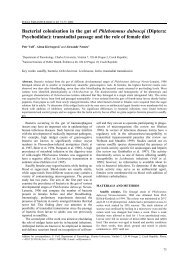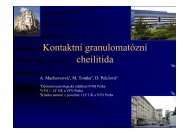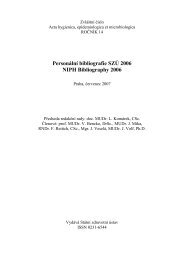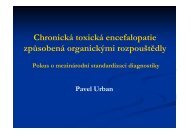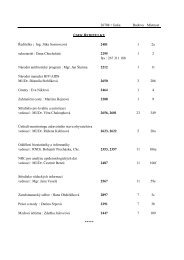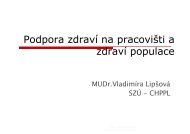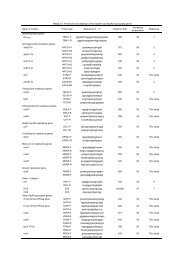Emergence of carbapenem resistance in Acinetobacter baumannii ...
Emergence of carbapenem resistance in Acinetobacter baumannii ...
Emergence of carbapenem resistance in Acinetobacter baumannii ...
You also want an ePaper? Increase the reach of your titles
YUMPU automatically turns print PDFs into web optimized ePapers that Google loves.
Nemec et al.<br />
Table 1. Relationship between <strong>carbapenem</strong> MICs and the presence <strong>of</strong> genes associated with the decreased susceptibility or <strong>resistance</strong> to<br />
<strong>carbapenem</strong>s <strong>in</strong> 108 A. <strong>baumannii</strong> isolates<br />
No. <strong>of</strong> isolates<br />
MIC <strong>of</strong> imipenem/meropenem (mg/L)<br />
Genes a<br />
0.25 0.5 1 2 4 8 16 .16<br />
Total no. <strong>of</strong> isolates<br />
No gene b (non-EU clone II) 35/34 2/4 2/1 0/0 0/0 0/0 0/0 0/0 39<br />
No gene (EU clone II) 3/0 1/4 22/17 4/7 3/5 0/0 0/0 0/0 33<br />
c<br />
ISAba1-bla OXA-51-like 0/0 0/0 0/0 13/8 5/5 10/3 4/9 0/7 32 d<br />
ISAba1-bla OXA-51-like þ bla OXA-58-like 0/0 0/0 0/0 0/0 0/0 2/2 0/0 0/0 2 e<br />
bla OXA-58-like 0/0 0/0 0/0 0/0 0/1 1/0 0/0 0/0 1 f<br />
bla OXA-24-like 0/0 0/0 0/0 0/0 0/0 1/0 0/1 0/0 1 f<br />
a All isolates were positive for the bla OXA-51-like gene and negative for the genes encod<strong>in</strong>g OXA-23-like, IMP, VIM and SIM-1 <strong>carbapenem</strong>ases.<br />
b Neither bla OXA-24-like , bla OXA-58-like nor ISAba1 located <strong>in</strong> the bla OXA-51-like promoter region was detected.<br />
c ISAba1 located <strong>in</strong> the promoter region <strong>of</strong> the bla OXA-51-like gene.<br />
d All except one were EU clone II isolates.<br />
e EU clone II isolates.<br />
f Non-EU clone II isolates.<br />
32 mg/L, whereas those aga<strong>in</strong>st 40 isolates without ISAba1 <strong>in</strong><br />
the promoter region were 8 mg/L (Figure 1).<br />
Both the adeB and adeS genes that are associated with the<br />
AdeABC efflux system were detected <strong>in</strong> 96 isolates, while seven<br />
isolates were negative for both genes and five isolates were positive<br />
for only one <strong>of</strong> the genes. Only the isolates positive for both<br />
genes showed <strong>in</strong>creased netilmic<strong>in</strong> MICs (4 mg/L) (Figure 1),<br />
which may <strong>in</strong>dicate up-regulation <strong>of</strong> the efflux. 8 The class 1 <strong>in</strong>tegrase<br />
gene was found <strong>in</strong> 60 isolates (belong<strong>in</strong>g to either clone I or<br />
II) and was unequivocally associated with the aacC1 and aadA1<br />
genes and with PCR products obta<strong>in</strong>ed with the primers aimed to<br />
amplify variable <strong>in</strong>tegron regions. Three different variable<br />
regions with the respective sizes <strong>of</strong> 2.5, 3.0 and 3.5 kb were<br />
detected (Figure 1), and restriction analysis and PCR mapp<strong>in</strong>g <strong>of</strong><br />
these structures revealed that they conta<strong>in</strong>ed the same genes <strong>in</strong><br />
the same order [aacC1-(orfX) 1-3 -orfX 0 -aadA1], differ<strong>in</strong>g only <strong>in</strong><br />
the number <strong>of</strong> orfX copies. 13<br />
Heterogeneity <strong>of</strong> <strong>resistance</strong> phenotypes and genotypes<br />
with<strong>in</strong> EU clone II isolates<br />
The susceptibility rates <strong>of</strong> clone II isolates (n ¼ 66) accord<strong>in</strong>g to<br />
the MIC and the CLSI breakpo<strong>in</strong>ts 9 were as follows (% susceptible<br />
isolates): imipenem (76), meropenem (70), ceftazidime (5), piperacill<strong>in</strong><br />
(0), ampicill<strong>in</strong> þ sulbactam (23), gentamic<strong>in</strong> (14), tobramyc<strong>in</strong><br />
(80), amikac<strong>in</strong> (68), netilmic<strong>in</strong> (12), sulfamethoxazole þ<br />
trimethoprim (12), doxycycl<strong>in</strong>e (6), cipr<strong>of</strong>loxac<strong>in</strong> (0) and colist<strong>in</strong><br />
(98). As many as 21 different <strong>resistance</strong> pr<strong>of</strong>iles were identified<br />
among these isolates and a similar heterogeneity was revealed at<br />
the gene level. The isolates were positive for the tested genes as<br />
follows (% PCR-positive isolates): bla TEM-1-like (80), tet(B) (92),<br />
tet(A) (5), aacC1 (83), aphA1 (80), aphA6 (30), bla OXA-58-like (3),<br />
<strong>in</strong>tI1 (83) and ISAba1 (95). The <strong>in</strong>tegron variable regions <strong>of</strong> 2.5, 3<br />
and 3.5 kb were found <strong>in</strong> 8, 46 and 1 isolate, respectively.<br />
Individual stra<strong>in</strong>s carried from 6 to 12 <strong>resistance</strong>-associated genes<br />
<strong>in</strong> 17 different comb<strong>in</strong>ations. Some isolates with the same PFGE<br />
patterns and obta<strong>in</strong>ed from the same ICU (e.g. NIPH 2893 and<br />
NIPH 2873) differed <strong>in</strong> the comb<strong>in</strong>ation <strong>of</strong> <strong>resistance</strong> genes,<br />
whereas other isolates <strong>in</strong>dist<strong>in</strong>guishable from each other by genotype<br />
and phenotype orig<strong>in</strong>ated from different cities (e.g. NIPH<br />
2601 and NIPH 2991) (Figure 1).<br />
Discussion<br />
Of the 150 Ac<strong>in</strong>etobacter isolates <strong>in</strong> the present study, 146<br />
(97%) were identified as A. <strong>baumannii</strong> (72%) or other genomic<br />
species <strong>of</strong> the Ac<strong>in</strong>etobacter calcoaceticus–A. <strong>baumannii</strong><br />
complex (25%). Nearly all stra<strong>in</strong>s resistant to multiple antimicrobial<br />
agents belonged to A. <strong>baumannii</strong>, and the vast<br />
majority <strong>of</strong> these MDR isolates were allocated to EU clone I or<br />
II. These results are consistent with those <strong>of</strong> our retrospective<br />
study on the A. calcoaceticus–A. <strong>baumannii</strong> complex isolates<br />
collected <strong>in</strong> Czech hospitals <strong>in</strong> 1991–97. 3,6 However, whereas <strong>in</strong><br />
the present study, 5 and 66 isolates were allocated to clones I<br />
and II, respectively, 39 and 9 isolates from the 1990s were<br />
classified <strong>in</strong>to the respective clones. Even though the results <strong>of</strong><br />
the two studies are not directly comparable as the stra<strong>in</strong><br />
<strong>in</strong>clusion criteria differed, the data suggest a shift <strong>in</strong> the recent<br />
A. <strong>baumannii</strong> population towards clone II.<br />
In the present study, 90% <strong>of</strong> the isolates with decreased susceptibility<br />
or <strong>resistance</strong> to <strong>carbapenem</strong>s (1 mg/L) and 83% <strong>of</strong><br />
those resistant to one or more non-<strong>carbapenem</strong> agents belonged<br />
to EU clone II. The wide spread <strong>of</strong> clone II may have resulted<br />
from its selective advantage <strong>in</strong> the antibiotic-rich hospital<br />
environment and could further be facilitated by the absence <strong>of</strong><br />
effective measures to prevent the transmission <strong>of</strong> MDR microorganisms,<br />
a problem commonly encountered <strong>in</strong> Czech hospitals.<br />
Other European studies have also recently reported on the spread<br />
<strong>of</strong> stra<strong>in</strong>s <strong>of</strong> clone II and on the association <strong>of</strong> <strong>carbapenem</strong> <strong>resistance</strong><br />
with these stra<strong>in</strong>s. 18,19 EU clone II thus seems to be particularly<br />
successful <strong>in</strong> its spread <strong>in</strong> European countries and it is<br />
conceivable that the ability <strong>of</strong> clone II stra<strong>in</strong>s to develop <strong>carbapenem</strong><br />
<strong>resistance</strong> has substantially contributed to this spread.<br />
Neither metallo-b-lactamase activity nor the genes encod<strong>in</strong>g<br />
these enzymes were detected <strong>in</strong> any <strong>of</strong> the studied isolates.<br />
488




